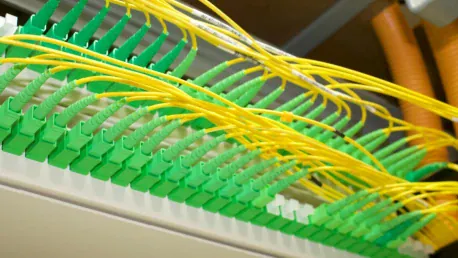The quest for universal broadband access in the United States has been a significant policy focus, especially with the establishment of the Broadband Equity, Access, and Deployment (BEAD) program. This initiative aims to close the internet access gap across different demographic groups and ensure that underserved communities gain the connectivity they need. However, recent analysis by the Information Technology & Innovation Foundation (ITIF) points out that the program’s heavy reliance on fiber optic technology might be limiting its effectiveness and financial sustainability. By focusing extensively on fiber optics, BEAD risks straining its budget without effectively reaching all Americans who lack high-speed internet access.
The High Cost of Fiber Optics
Fiber optic technology is praised for its high performance and durability, but these benefits come at a substantial cost. According to the ITIF report, the high upfront expenses associated with fiber deployment could strain the BEAD program’s budget, which was allocated $42.45 billion to extend broadband access to underserved communities. Given these financial challenges, the reliance on expensive fiber optic projects may ultimately limit the program’s ability to achieve its goal of universal broadband access for all Americans. Joe Kane, ITIF’s Director of Spectrum and Broadband Policy, argues that the current guidelines of the program, which favor fiber, are outdated and do not adequately account for recent technological advancements in other areas, such as low-Earth-orbiting (LEO) satellites and fixed wireless broadband.
These alternatives offer more cost-effective solutions and could help stretch the BEAD program’s budget further, enabling it to achieve broader coverage. Technological advancements in satellite and wireless broadband suggest that these options are not only viable but also highly effective in delivering high-speed internet access.
The Case for Technology Neutrality
A technology-neutral approach to broadband deployment could provide significant financial savings and enhance the program’s reach. By incorporating alternative technologies like LEO satellites and fixed wireless broadband, the BEAD program could serve more communities at a lower cost, ensuring that high-speed internet is accessible to a wider population. These technologies have evolved considerably since the program’s inception, making them viable options for delivering efficient internet connectivity.
According to Kane and Research Assistant Ellis Scherer, reassessing BEAD’s guidelines to reflect these technological advancements is essential. By reducing the emphasis on fiber optics, the program could allocate its resources more efficiently and address other critical issues. These include the affordability of internet services for low-income households and enhancing digital literacy, both of which are vital components in bridging the digital divide. Essentially, adopting a technology-neutral approach would allow BEAD to be more financially sustainable while having a wider-reaching impact.
The Benefits and Limitations of Alternative Technologies
While fiber optics offer long-term benefits, including high performance and durability, alternative technologies like LEO satellites and fixed wireless broadband also present their own advantages. LEO satellites, for instance, are especially beneficial for providing internet access to extremely rural households where fiber deployment may not be feasible. Fixed wireless broadband, including innovations in 5G technology, offers a cost-effective solution for expanding coverage in less densely populated areas and can be quickly deployed compared to the more time-consuming process of laying fiber cables.
However, these technologies are not without their limitations. LEO satellites require replacement approximately every five years, which can lead to repeated expenses over time. Additionally, satellite networks may face congestion issues as the number of users increases, potentially impacting performance and reliability. Despite these challenges, Kane suggests that these technologies could still be effective in rural and remote areas, where demand for internet services might not be as high, thus minimizing the risk of congestion.
Political and Administrative Challenges
The management of the BEAD program has also come under scrutiny. John Strand of Strand Consulting argues that the National Telecommunications and Information Administration (NTIA) should not have been responsible for the program’s oversight. Instead, he believes that the Federal Communications Commission (FCC), with its extensive experience in subsidy distribution and bipartisan accountability, would have been a better fit for managing the initiative. According to Strand, political motivations influenced NTIA’s preference for fiber, with economic implications and workforce involvement being underlying factors.
Strand also highlights additional administrative delays caused by NTIA’s implementation of climate and Diversity, Equity, and Inclusion (DEI) requirements. These requirements, which were not mandated by Congress, faced resistance from certain states and added to the program’s complexities. He suggests that these administrative challenges further complicate the program’s execution and diminish its potential effectiveness.
The Need for a Balanced Approach
Given the complexities of ensuring universal broadband access in the U.S., a well-rounded, flexible approach that leverages multiple technologies could better address these challenges. No single technology is always the optimal solution for every scenario. A blend of fiber optics, LEO satellites, and fixed wireless broadband could provide a balanced and cost-effective deployment strategy. By utilizing a mix of technologies, policymakers can ensure that different communities receive the most suitable and practical form of internet connectivity.
Jim Dunstan, general counsel for TechFreedom, underscores the impact of inflation on the program’s budget, noting that the allocated $42.5 billion is insufficient to achieve universal broadband access, regardless of the technology used. While he acknowledges fiber’s performance advantages, he also recognizes the need for more pragmatic approaches to the deployment strategy. By combining various technologies, the program can better navigate financial constraints and technological limitations, ultimately maximizing its impact and reach.
The Future of Broadband Deployment
The push for universal broadband access in the United States has been a key policy goal, particularly highlighted by the launch of the Broadband Equity, Access, and Deployment (BEAD) program. This initiative is dedicated to bridging the internet access divide among various demographic groups and ensuring that underserved communities receive the connectivity they require. However, a recent analysis by the Information Technology & Innovation Foundation (ITIF) suggests that the BEAD program’s strong emphasis on fiber optic technology might be undermining its effectiveness and long-term financial viability. By focusing predominantly on fiber optics, BEAD risks overextending its budget and failing to effectively provide high-speed internet to all Americans who currently lack access. This overreliance could potentially hinder the program’s goal of equitable internet distribution. The analysis recommends exploring alternative technologies and infrastructure solutions that could complement fiber optics, thereby ensuring broader and more cost-effective internet coverage across the nation.









